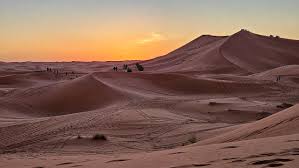The Sahara Desert: A Majestic Sea of Sand
The Sahara Desert, located in North Africa, is the largest hot desert in the world, spanning over 9 million square kilometres. Its vast expanse of golden sand dunes and rocky plateaus creates a surreal landscape that has captivated travellers and explorers for centuries.
Geography and Climate
The Sahara stretches across multiple countries including Morocco, Algeria, Tunisia, Libya, Egypt, Mauritania, Mali, Niger, Chad, and Sudan. Despite its arid reputation, the Sahara is not just a sea of sand; it also features mountains, oases, and even seasonal rivers.
The climate in the Sahara is extreme, with scorching daytime temperatures often exceeding 50°C (122°F) and plummeting to near freezing at night. Rainfall is scarce and irregular, making water sources precious and sparse.
Flora and Fauna
Despite its harsh conditions, the Sahara supports a surprising variety of plant and animal life. Adapted to survive in this unforgiving environment are species such as camels, desert foxes, scorpions, and various types of snakes.
Vegetation includes drought-resistant plants like acacia trees and date palms that thrive in the desert’s oases. These green havens provide crucial resources for both wildlife and nomadic communities.
Cultural Significance
The Sahara has been home to numerous indigenous Berber tribes for millennia. These nomadic peoples have developed unique ways of life that revolve around herding livestock like goats and camels across vast distances in search of water and grazing land.
Rich in history and mystery, the Sahara boasts ancient rock art sites dating back thousands of years. These engravings offer glimpses into past civilisations that once thrived amidst the desert’s shifting sands.
Tourism and Adventure
For intrepid travellers seeking adventure, exploring the Sahara offers an unforgettable experience. From camel treks through dunes to camping under starlit skies in Bedouin tents, visitors can immerse themselves in the timeless beauty of this majestic desert.
Guided tours allow visitors to witness stunning sunrises and sunsets over the endless horizon while learning about the region’s history from knowledgeable guides. Sandboarding down steep dunes or riding on 4×4 vehicles are popular activities for adrenaline enthusiasts.
Preserving a Natural Wonder
As climate change poses new challenges to fragile ecosystems worldwide, conservation efforts in the Sahara are crucial to protect its unique biodiversity. Sustainable tourism practices aim to minimise environmental impact while supporting local communities dependent on tourism for their livelihoods.
Essential Tips for a Safe and Enjoyable Sahara Desert Adventure
- Stay hydrated by drinking plenty of water to avoid dehydration in the hot and arid climate.
- Protect yourself from the sun by wearing sunscreen, a hat, and sunglasses to prevent sunburn and heatstroke.
- Wear lightweight and loose-fitting clothing to stay cool during the day and layer up for colder nights.
- Be cautious of desert wildlife such as scorpions and snakes; avoid touching or approaching them.
- Plan your journey carefully, inform others of your itinerary, and consider hiring a local guide for a safer desert experience.
Stay hydrated by drinking plenty of water to avoid dehydration in the hot and arid climate.
In the Sahara Desert, where temperatures soar and water sources are scarce, it is essential to stay hydrated by drinking plenty of water to prevent dehydration in the hot and arid climate. The harsh conditions of the desert can quickly lead to heat exhaustion and other health risks if adequate hydration is not maintained. Be sure to carry enough water with you at all times and replenish your fluids regularly to stay healthy and safe while exploring this magnificent but challenging environment.
Protect yourself from the sun by wearing sunscreen, a hat, and sunglasses to prevent sunburn and heatstroke.
To safeguard against the intense sun of the Sahara Desert, it is essential to shield yourself by applying sunscreen, donning a wide-brimmed hat, and wearing sunglasses. These protective measures not only help prevent sunburn but also reduce the risk of heatstroke, ensuring a safer and more enjoyable experience exploring this vast and awe-inspiring landscape.
Wear lightweight and loose-fitting clothing to stay cool during the day and layer up for colder nights.
To combat the extreme temperatures of the Sahara Desert, it is advisable to dress strategically. Opt for lightweight and loose-fitting clothing to stay cool during the scorching daytime heat. As the desert cools down significantly at night, layering up with warmer clothing will help you stay comfortable and insulated against the chilly winds. By adapting your attire to the desert’s contrasting temperatures, you can ensure a more enjoyable and practical experience exploring this majestic landscape.
Be cautious of desert wildlife such as scorpions and snakes; avoid touching or approaching them.
When venturing into the Sahara Desert, it is essential to exercise caution regarding desert wildlife, including scorpions and snakes. These creatures are adapted to survive in the harsh desert environment and may pose a threat if provoked. It is advisable to refrain from touching or approaching them to ensure your safety and respect their natural habitat. Stay vigilant and admire these fascinating creatures from a safe distance while exploring the majestic landscape of the Sahara.
Plan your journey carefully, inform others of your itinerary, and consider hiring a local guide for a safer desert experience.
When embarking on an adventure in the Sahara Desert, it is essential to plan your journey meticulously, inform trusted individuals of your intended itinerary, and contemplate engaging a local guide for a more secure desert experience. The vast and challenging terrain of the Sahara demands careful preparation to ensure safety and enjoyment. Local guides possess invaluable knowledge of the region’s nuances, enhancing your understanding of the environment and minimising potential risks. By taking these precautions, you can navigate the desert with confidence and create lasting memories while prioritising your well-being.

